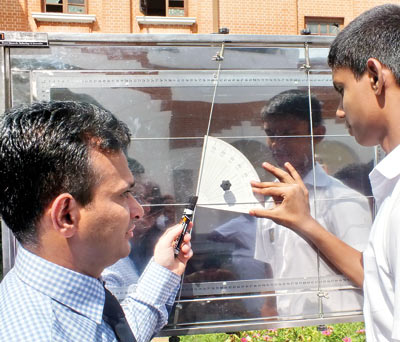Path-breaking Maths method developed by Sri Lankan could help weak Maths students worldwide

Teacher N. A. Asmeer Ahamed shows a student how to use the All-in-one –Mathematics Kit
Over the years, it has been observed that the failure rate in Mathematics in the Grade VI to XI levels in Sri Lanka is more than 50 per cent.
Given this high failure rate and looking for solutions to reduce the failure rate, a Maths teacher, when he was teaching at the Dickpitiya Muslim Maha Vidyalaya, Mawanella, developed a practical method of teaching Mathematics where the failure rate could be brought down sharply to just 5 per cent. This innovative concept is called ‘All-in-one-Mathematics Board’ (Kit) and is result-oriented. The teacher, N. A. Asmeer Ahamed, now teaching Science and Maths at Royal College, Colombo, in 2013 invented and developed the All-in-one –Mathematics Kit which is considered to be the first in the world.
High failure rate
When he joined the Dickpitiya Muslim MV the failure rate at that school was 67 per cent and with his practical teaching method the failure rate has dropped to 5 per cent. Soon, the new method would be introduced to the national educational streams. The project is supported by the National Science Foundation (NSF) with a grant of some Rs, 250,000 aimed at modifying and making the whole instrument portable. At present the instrument is quite heavy and needs a mathematics lab to make it work.
Last week Ms. Nadeeja Wickramarachchi, Senior Scientific Officer, Technology Division, NSF accompanied the Business Times to Royal College, to observe a demonstration with a group of senior students, organised by Mr. Ahamed to show how the Mathematics Kit operates. It is an instrument with about a 3’ x 3’ rotatable board where both sides could be used – one side for geometry and the other side used for graphs demonstration. The geometry side is equipped with two parallel movable strings and with another horizontal string cutting across the two parallel strings. These strings could be moved to demonstrate how to exactly measure the values of corners.
Saves time
The other side is full of squares (about 1 ½’ x 1 ½’) and there are plastic magnetic buttons which can be plotted in marking the graph. Students absorb these demonstrations very easily, save time and is environmentally friendly as there is no dust because no chalk or chemicals are used.
While explaining to the students who gathered in the college garden, Mr. Ahamed told the Business Times that these demonstrations can be easily absorbed by the students. The major functions of the Kit are Probability Zone (entire Probability theorem); Graph Zone (Graph theorem); Geometry Zone (Geometry theorem), Trigonometry Zone (Trigonometry theorem); Circular Geometry Zone; Sets Zone; Algebra zone and Area and Perimeter zone.
Fifteen years of his teaching life so far, he said, was devoted to formulate this novel Kit which has won several national awards and international appreciations. “Three scientists represented Sri Lanka at the Indian Ocean Rim Association for Regional Cooperation IOR-ARC Regional Centre for Science and Technology Transfer – The 5th Fair International Inventions and Innovations Exhibition at Tehran, Iran on 4-7 February 2013 and I was one of the three”. He said that more than 86 countries participated and his exhibit was appreciated. He said that with these exceptional achievements, he had applied to NSF for financial support.
Invention could benefit world
Ms. Wickramarachchi said that their involvement in the project involves helping the creator to modify the board and made some improvements. The proposed follow-up action regarding output is to obtain Patent/Industrial Design and islandwide promotion of the All in One Math Board (Kit) through technology transfer. Dr. Thamara Dias, Head, Technology Division, NSF told the Business Times that the Maths Kit is a viable scientific innovation that could benefit the entire world, specially countries where Mathematics results (as a subject) are weak. With a proper focus, Sri Lanka could sell the product overseas, and at the same time it could be a boost to the economy, as more and more Mathematicians could be absorbed into the Sri Lankan job market.


